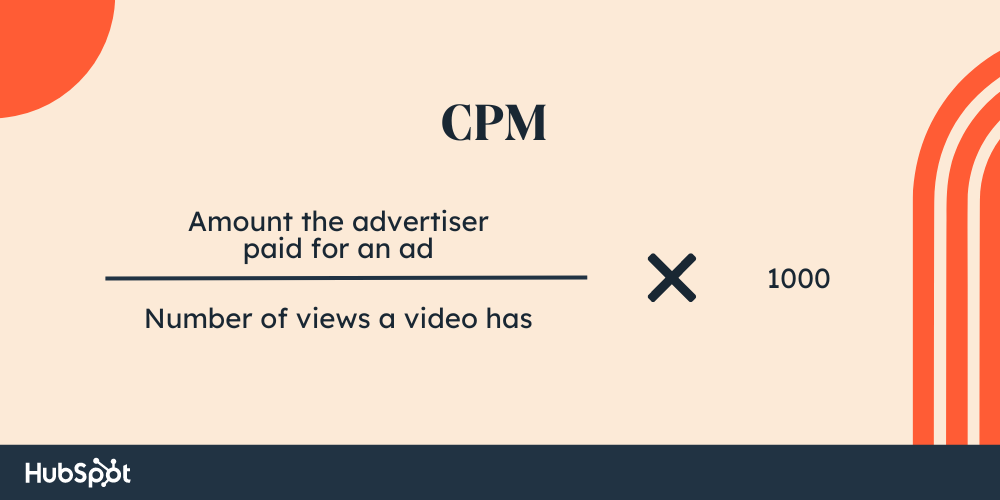YouTube is a powerful advertising platform with over two billion monthly active users. As a creator, this means you have numerous opportunities to earn money. Understanding YouTube CPM is key to unlocking its potential.
CPM, Cost per 1,000 Impressions, is a vital metric that determines how much advertisers pay to reach viewers through your videos.
It’s commonly used across various paid media platforms to describe the advertising expenditure per 1,000 individuals reached by the ad.
By maximizing your YouTube CPM, you increase your earnings and demonstrate the value of your content. In this article, we‘ll explore what CPM is, how it’s calculated, what makes a “good CPM,” and more.
Table of Contents
- What is CPM, and how is it calculated?
- Why is CPM important?
- The Average CPM on YouTube
- The Highest CPM on Youtube
What is CPM, and how is it calculated?
CPM, or cost per 1,000 impressions, is the cost an advertiser needs to pay on YouTube for every 1,000 impressions their ads receive on your video.
CPM varies depending on how much an advertiser pays to display the ad. Advertising costs on YouTube depend on a range of factors, including bidding price, ad type, and consistency.
To calculate CPM, divide the amount the advertiser paid for an ad by the number of views a video has. Then, multiply by 1,000.

For instance, let‘s assume an advertiser is paying $9 for an ad seen 5,000 times on your video. To calculate CPM, you’d divide nine by 5,000 = $0.0018, then multiply $0.0018 by 1,000.
This gives you a CPM of $1.80. YouTube takes 45% of your CPM, meaning you‘ll receive 55% of that $1.80. So, if you make $1.80 CPM off an ad, you’ll only keep $0.99.
Additionally, there’s another type of CPM: playback-based CPM.
Rather than calculating the cost the advertiser pays for 1,000 impressions, playback-based CPM calculates the cost an advertiser pays for 1,000 video playbacks where an ad is displayed.
There are free calculators available online if you don’t want to calculate your CPM manually.
And while individual videos’ CPMs might seem small (like the $0.99 made above), it can add up to a hefty monthly earning if plenty of businesses see your videos as consistently worthwhile platforms for their promotions.
Why is CPM important?
As a YouTube creator, CPM is an important metric for analyzing which of your videos are most valuable to advertisers.
Since advertising is the primary method for monetization on YouTube, it’s essential to understand how CPM works to ensure you’re maximizing revenue.
To make a full-time career out of YouTube, it’s critical to know which videos can be monetized so you can create a more efficient, long-term strategy to target those types of topics.
For instance, perhaps you create YouTube videos for beauty, health, and wellness. But you find “Drugstore Makeup Tutorials” receive the highest CPMs. This suggests you should make more content that aligns with that topic.
One of the best ways to increase your CPM is to make your channel an ideal space for advertisers to place their ads.
YouTube research has found that ad exposure (ensuring their ads reach people multiple times per week) significantly improves advertising ROI.
Advertisers consistently placing ads on your videos benefits them, earning you higher CPM and increased revenue.
Additionally, if you find one business in particular consistently advertises on your videos.
If the brand aligns with your values, you might reach out directly to discuss other YouTube monetization opportunities, like affiliate marketing or brand partnerships.
The Average CPM on YouTube
CPM varies greatly depending on how much an advertiser pays to distribute an ad on your video.
Let‘s say an advertiser pays $10 for an ad that plays on your video with 1,000 views. If that’s the case, you‘d make $10 CPM (10/1,000 x 1,000). Of course, you’ll need to take 45% off that total — making your earnings around $5.
However, in most cases, the videos on which businesses choose to advertise will have more than 1,000 views, making your earnings closer to $7-$10.
Jillian Hope, HubSpot’s Senior Manager of Brand Advertising, agrees, telling me her team typically sees an average of $7 to $10 from past campaigns.
It’s important to note that CPM is just one metric that you can use to analyze and improve your YouTube performance.
For example, YouTube analytics provide metrics like revenue per mille (RPM), which shows how much you’re earning per 1,000 video views across multiple revenue sources.
The Highest CPM on YouTube
The highest CPM varies by country, but here’s a list of the five highest YouTube CPM rates by country from 2022-2023:
- Norway: $43.15
- Germany: $38.85
- Moldova: $29.50
- Algeria: $24.50
- South Korea: $17.00
Higher CPM rates also relate to the content of your videos. Some categories earn higher CPMs than others. Some popular content niches on YouTube that earn high CPMs include:
- Makeup
- Retail
- Health
- Finance
- Technology
But video topics aren’t the only factor that can make your CPM fluctuate. Many creators report peaks and troughs in their CPM throughout the year.
For example, seasonal shopping around the holidays throughout November and December can temporarily drive up YouTube earnings in certain niches.
Getting Started
As a creator, you should use CPM as a metric to help you identify which topics seem most valuable to advertisers, as those topics likely provide the most opportunity for monetization.
Rather than looking for “quick tricks” to increase your CPM, however, you’ll want to play the long game by creating a comprehensive YouTube strategy that helps you increase sales, reach new audiences, and grow brand awareness.
![]()

![→ Free Templates: How to Use YouTube for Business [Download Now]](https://i4lead.com/wp-content/uploads/2023/09/b33cfd44-133a-49e3-a943-086c5679d485.png)
